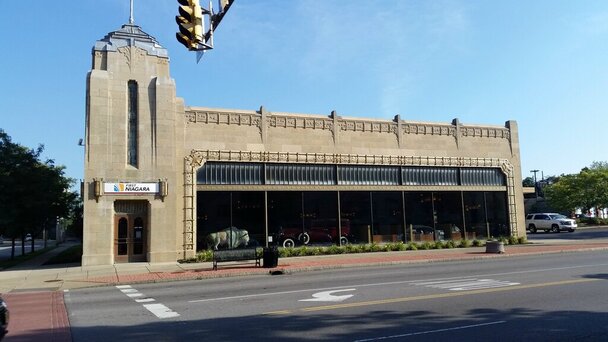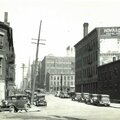
This ca. 1895 photo of a farmhouse along Main Street proved to have a fascinating story behind it.
Courtesy Bud Tinney
In our summer issue, we promised to share another of the photos sent in by our readers. Back in May, we received a package from long-time subscriber, Bud Tinney, from Grand Rapids, MI, in response to my request for images relating to Western New York. Bud was kind enough to trust us with an original photo of a farmhouse, which was torn down in the late 1920s.
At first glance, a casual observer might be taken with the bucolic setting of the photo—a small house complete with white picket fence and carriage step at the curb. But few would probably guess at the Buffalo history linked to the scene. As we dug deeper into the history of the house, and the lot on which it sat, a very interesting picture began to unfold—one which we wanted to share with our readers.
When Bud sent the photo along to us, he had mentioned that the house had been razed in 1928 to make room for a new Pierce-Arrow showroom, built in 1929 on Main Street at the corner of Jewett Avenue. This striking, Art Deco structure has since become a familiar architectural landmark in Buffalo, and was featured on the cover of our Fall 2008 issue. But what was most interesting about the house—and the photo—was what had come before, not after.

Our Fall 2008 cover featured V. Roger Lalli’s painting of the Pierce-Arrow showroom building, opened on the site in 1929. By this time, Braun Cadillac was operating out of the Art Deco landmark.
Western New York Heritage collection
On the back of the photo, there is a lengthy narrative, written in pencil, by one the property’s last owners, Harry T. Buttolph. It makes for interesting reading and provides some evocative clues as to the significance of the property. In part, it reads:
Torn down week of May 25, 1928.
Our family arrived in Buffalo from Essex, Chittenden Co., Vermont Tuesday morning March 30, 1869, and were driven out to the “Farm” in the family carriage, and a “Democrat” wagon. Main Street was paved with a rough old stone pavement to Scajaquada Creek, and from there out to the “Farm,” (now Jewett Ave) an extremely muddy McAdam [sic] Road.
There to be our future home was the old manse recently painted yellow. After standing probably since 1820 facing summer sun and winter blasts for there were traces of weather worn boards when we first came.
The photo is labeled as having been taken about 1895. While an evocative passage to be sure, there is nothing particularly unique about the information contained here. In fact, aside from the specific details, it might have been written by any number of individuals who made their way to Western New York in the 19th century. Following this opening passage, Mr. Buttolph included snippets relating to the history of the property on which the “old manse” was situated.
Another conversation with Mr. Tinney resulted in a second package arriving at our office—this one containing the abstract for the property, down to the mid-20th century. This document allowed us to fill in some gaps in the history we already suspected was unfolding, based on research into details of the photo and the Buttolph genealogy, while serving to better focus our further efforts.
The property on which the home sat was purchased in August 1815 from agents of the Holland Land Company by Zachariah Griffin. One of the infamous “Plains Rangers,” Griffin first settled on the east side of what is now Main Street around 1808. The following year he constructed a small house near the modern intersection of Greenfield Street, which was considered the oldest in Buffalo when it was razed in 1915. Griffin must have been expanding his holdings to the south with the 1815 purchase. It is likely that the house in the photograph was constructed for Griffin’s relatives, who desired to live nearby. This would confirm the date of ca. 1820 listed on the back of the photo. Neighbors along the street at this point included such significant names as Samuel Atkins and Dr. Daniel Chapin, whose farm stood across Main Street, just north of Erastus Granger’s farm.

Elam Richardson Jewett’s Willowlawn estate would become a portion of the Parkside neighborhood, with the road constructed through his former estate—Jewett Parkway—bearing his name. In the late 1860s, Jewett’s sister and her family came to Western New York and lived in the small farmhouse across Main Street from his estate.
Western New York Heritage collection
The land stayed in the Griffin family until 1835, when it was sold to early Buffalo developer, Benjamin Rathbun. Rathbun’s financial difficulties a few years later are fairly well known, and not long afterwards, the parcel on Main Street was among the assets turned over to a group of Rathbun’s creditors, which reads like a who’s who of Buffalo figures at the time: Lewis F. Allen, Hiram Pratt, Joseph Clary, Thomas C. Love and Millard Fillmore, among others. The Rathbun mortgage was foreclosed on, and by 1841 the property was in the hands of Elbridge Gerry Spaulding. Spaulding, in turn deeded the property to one Henry Streater in 1846. Among Streater’s claims to fame was his role in purchasing land near Medina, NY for use as a quarry, providing the source for the stone used to construct St. Paul’s Episcopal Cathedral.
The property changed hands again in the mid-1850s, and in November 1864 it was purchased by the publisher of The Commercial Advertiser, Elam Richardson Jewett. That same year, Jewett had purchased the Willowlawn estate just across Main Street, which had been established first by Dr. Daniel Chapin and then his son William. Jewett had come to Buffalo from Vermont in the late 1830s, having purchased The Buffalo Journal from Samuel Wilkeson, which he eventually merged with the Advertiser.
All of this brings us back to March 1869, and the arrival of the Buttolph family from Vermont. Having been born in May 1855, young Harry was in his teens when the family packed up and moved to Western New York. While he records his impressions of the structure he would call home for the next several decades, he remains silent about the people he refers to in his opening sentence as “our family.” That family included his parents, Elam Jewett Buttolph and his wife Mary, uncle Othniel Buttolph, younger brothers John and Benjamin—and grandmother Abigail Nash Jewett.
Abigail Jewett was Elam Richardson Jewett’s sister, making Jewett young Harry’s great uncle. Upon the death of her husband, John Phelps Buttolph, in 1856, Abigail went to live with her son Elam, who had been named for his uncle. Elam Buttolph is listed in the 1870 U.S. Census as a farmer, so perhaps Jewett felt the need for additional help with his recently acquired estate and thus invited his widowed sister and nephew to join him in Buffalo. Whatever the reason, members of the Buttolph family would call the property their home until 1926.

This 1880 map shows Elam Richardson Jewett’s property straddling Main Street, along with its proximity to The Park. The property shown in the farmhouse photo is highlighted in blue. The future path of Jewett Parkway can be seen traced through Jewett’s estate.
Western New York Heritage collection
Abigail died in Buffalo in 1874. In October 1886, Elam R. Jewett and his wife, Caroline, deeded the majority of the property on the east side of Main Street to nephew Elam Buttolph, with the remainder of the property coming to him following E. R. Jewett’s death the following year. Though a small parcel (Parcel “E”) was deeded to Harry Buttolph by his parents in 1892, the remainder of the property passed jointly to Harry and his two brothers, John and Benjamin, upon their father’s death in 1899. Elam’s wife, Mary, was granted the “use, enjoyment, rents, issues and profits” from the estate for the remainder of her life.
Harry continued to live in the house with his widowed mother and bachelor brother John until about 1905, when he and his wife, Clara, rented a house at 2574 Main Street, further up and across the street on the northwest corner of its intersection with Orchard Place. Youngest brother, Benjamin, was evidently no longer in the house and eventually ended up in Rhode Island. Mary Buttolph died in 1914, followed by her middle son, John, in 1927.
Perhaps John was not in the home during the final year of his life, thus providing impetus for the decision to sell the property to the Pierce-Arrow Sales Company of Buffalo, beginning in January 1926. In 1929, Pierce-Arrow opened their iconic Art Deco showroom on the property, designed by H.E. Plumer Associates and Harold F. Kellogg—just in time for the Great Depression. The company fell on hard times and, by 1936, the showroom had passed to Maxson Cadillac, which operated the facility until 1957, when it became home to Tinney Cadillac. Braun Cadillac took over in 1981, but in 1998 they moved their facilities to Depew and sold the old showroom to Buffalo Savings Bank. First Niagara absorbed Buffalo Savings bank in 2007. As this issue goes to press, further change is in the wind, as the building’s façade maintains a temporary First Niagara sign, waiting be pulled down to reveal one announcing Key Bank’s ownership, the latest in a long and storied list of tenants to own this little corner.
Truly a picture IS worth 1,000 words—or in this case, a little over 1,400. Our sincere thanks to Mr. Tinney for sharing these important pieces of Western New York history with us!










